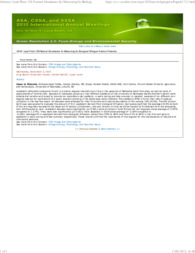Lead plant 15N natural abundance for measuring its biological nitrogen fixation potential.
Lead plant 15N natural abundance for measuring its biological nitrogen fixation potential.
Autoria: MIRANDA, C. H. B.; FOLLET, R.; SCHACHT, W.
Resumo: Leadplant (Amorpha canescens Pursh) is a prairie legume naturally occurring in the pastures of Nebraska Sand Hills area, as well as most of pasturelands of Central USA. Samples of Leadplant growing in two different paddocks of the University of Nebraska Bartha Brother's Ranch were collected at random and mixed to provide six replications per paddock, in early spring and late summer. In parallel, samples of six different non-legume species (or replications of a given species) growing in the same area were collected. The paddocks differ only by their rate of pasture utilization in the last few years. All samples were analyzed for their N content and natural abundance of the isotope 15N (d15N). The15N dilution technique was applied to evaluate the amount of N in Leadplant derived from biological N fixation, being assumed that the averaged d15N content of the non-legumes represents the basal soil N isotopic composition, and any dilution on that would be caused by N obtained from the atmosphe, with d15N equals to zero. Leadplant samples were significantly (p<0.001) more enriched in total N than the non-legumes (total average of 2.09% compared to 1.37%). They were also significantly (p<0.001) more depleted in d15N (total average of -2.049 compared to -4.294). Averaged N in Leadplant derived from biological N fixation varied from 39% to 46% and from 51% to 66% in the first and second paddocks in early spring and late summer, respectively. These results confirms the importance of this legume for the maintenance of natural and introduced pastures.
Ano de publicação: 2010
Tipo de publicação: Resumo em anais e proceedings
Unidade: Embrapa Gado de Corte
Palavras-chave: Amorpha canescens Pursh, Fixação de Nitrogênio, Pastagem, Pastures
Observações
1 - Por padrão são exibidas publicações dos últimos 20 anos. Para encontrar publicações mais antigas, configure o filtro ano de publicação, colocando o ano a partir do qual você deseja encontrar publicações. O filtro está na coluna da esquerda na busca acima.
2 - Para ler algumas publicações da Embrapa (apenas as que estão em formato ePub), é necessário ter, no celular ou computador, um desses softwares gratuitos. Sistemas Android: Google Play Livros; IOS: iBooks; Windows e Linux: software Calibre.
Acesse outras publicações
Acesse a Base de Dados da Pesquisa Agropecuária (BDPA) para consultar o acervo completo das bibliotecas da Embrapa.

